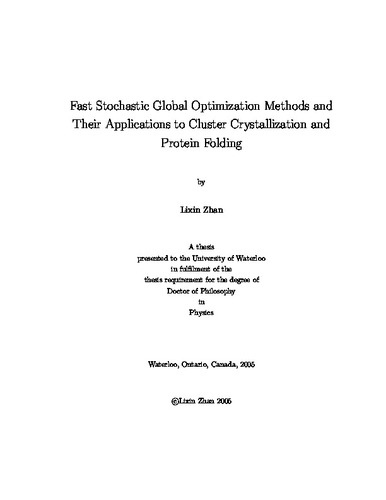| dc.contributor.author | Zhan, Lixin | en |
| dc.date.accessioned | 2006-08-22 14:35:17 (GMT) | |
| dc.date.available | 2006-08-22 14:35:17 (GMT) | |
| dc.date.issued | 2005 | en |
| dc.date.submitted | 2005 | en |
| dc.identifier.uri | http://hdl.handle.net/10012/1246 | |
| dc.description.abstract | Two global optimization methods are proposed in this thesis. They are the multicanonical basin hopping (MUBH) method and the basin paving (BP) method. <br /><br /> The MUBH method combines the basin hopping (BH) method, which can be used to efficiently map out an energy landscape associated with local minima, with the multicanonical Monte Carlo (MUCA) method, which encourages the system to move out of energy traps during the computation. It is found to be more efficient than the original BH method when applied to the Lennard-Jones systems containing 150-185 particles. <br /><br /> The asynchronous multicanonical basin hopping (AMUBH) method, a parallelization of the MUBH method, is also implemented using the message passing interface (MPI) to take advantage of the full usage of multiprocessors in either a homogeneous or a heterogeneous computational environment. AMUBH, MUBH and BH are used together to find the global minimum structures for Co nanoclusters with system size <em>N</em>≤200. <br /><br /> The BP method is based on the BH method and the idea of the energy landscape paving (ELP) strategy. In comparison with the acceptance scheme of the ELP method, moving towards the low energy region is enhanced and no low energy configuration may be missed during the simulation. The applications to both the pentapeptide Met-enkephalin and the villin subdomain HP-36 locate new configurations having energies lower than those determined previously. <br /><br /> The MUBH, BP and BH methods are further employed to search for the global minimum structures of several proteins/peptides using the ECEPP/2 and ECEPP/3 force fields. These two force fields may produce global minima with different structures. The present study indicates that the global minimum determination from ECEPP/3 prefers helical structures. Also discussed in this thesis is the effect of the environment on the formation of beta hairpins. | en |
| dc.format | application/pdf | en |
| dc.format.extent | 3267330 bytes | |
| dc.format.mimetype | application/pdf | |
| dc.language.iso | en | en |
| dc.publisher | University of Waterloo | en |
| dc.rights | Copyright: 2005,
Zhan, Lixin. All rights reserved. | en |
| dc.subject | Physics & Astronomy | en |
| dc.subject | Monte Carlo | en |
| dc.subject | Multicanonical Basin Hopping | en |
| dc.subject | Basin Paving | en |
| dc.subject | Protein Folding | en |
| dc.subject | Parallel Computing | en |
| dc.title | Fast Stochastic Global Optimization Methods and Their Applications to Cluster Crystallization and Protein Folding | en |
| dc.type | Doctoral Thesis | en |
| dc.pending | false | en |
| uws-etd.degree.department | Physics | en |
| uws-etd.degree | Doctor of Philosophy | en |
| uws.typeOfResource | Text | en |
| uws.peerReviewStatus | Unreviewed | en |
| uws.scholarLevel | Graduate | en |

